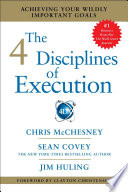

The first discipline emphasizes the importance of narrowing focus to a few crucial goals instead of spreading efforts too thin across multiple objectives. By identifying and committing to Wildly Important Goals (WIGs), teams can direct their energy and resources towards achieving these specific targets. This discipline encourages organizations to prioritize what truly matters, ensuring that every team member understands the most important goals and aligns their efforts accordingly. It also involves a clear communication strategy to convey these goals throughout the organization, fostering a shared vision and collective commitment among employees.
Continue readingThe second discipline focuses on identifying and acting on lead measures, which are predictive and influenceable indicators of success. Unlike lag measures that reflect outcomes (like revenue or market share), lead measures are proactive steps that can be taken to drive performance. For instance, if a WIG is to increase sales, a lead measure could be the number of sales calls made per week. This discipline encourages teams to track and improve these lead measures, as they directly impact the achievement of their WIGs, thus fostering a culture of accountability and continuous improvement.
Continue readingThe third discipline involves creating a visual and engaging scoreboard that tracks progress towards the WIGs and lead measures. This scoreboard serves as a motivational tool, allowing team members to see their progress in real-time and understand how their individual contributions impact the overall goals. An effective scoreboard is simple, visible, and easy to understand, making it an essential element in maintaining focus and motivation. By regularly updating the scoreboard, teams can celebrate milestones and address challenges promptly, reinforcing a sense of ownership and commitment to the WIGs.
Continue readingThe fourth discipline emphasizes the importance of establishing a regular rhythm of accountability meetings. These meetings provide a structured environment for team members to report on their progress, discuss challenges, and plan for the upcoming week. The cadence of accountability fosters a culture of transparency and responsibility, ensuring that everyone remains focused on their commitments. This discipline also encourages open communication and collaboration, allowing teams to share insights and support one another in overcoming obstacles, ultimately driving collective success.
Continue readingA critical aspect of executing the four disciplines is ensuring that the entire organization is aligned around the WIGs. This alignment involves cascading the goals down through all levels of the organization, ensuring that every team and individual understands how their work contributes to the larger objectives. It also requires leadership to model commitment to the WIGs, fostering a culture where everyone feels empowered to contribute. When alignment is achieved, it creates a unified direction, enhancing collaboration and synergy across departments.
Continue readingThe book discusses the concept of the 'whirlwind,' which refers to the daily tasks and operational pressures that can distract teams from their strategic goals. To successfully implement the four disciplines, organizations must find ways to manage the whirlwind effectively. This involves setting aside dedicated time for focus on WIGs and ensuring that teams do not get overwhelmed by reactive tasks. By recognizing the whirlwind's impact and implementing strategies to counteract it, organizations can maintain momentum towards their goals and avoid being sidetracked by day-to-day operations.
Continue readingThe final idea revolves around creating a culture that values and prioritizes execution. This culture is built on the principles of the four disciplines, where every team member understands their role in achieving the WIGs and feels accountable for their contributions. Leadership plays a crucial role in fostering this culture by providing support, resources, and recognition for efforts towards execution. A strong execution culture not only drives performance but also enhances employee engagement, satisfaction, and retention, as team members feel connected to the organization's success.
Continue reading